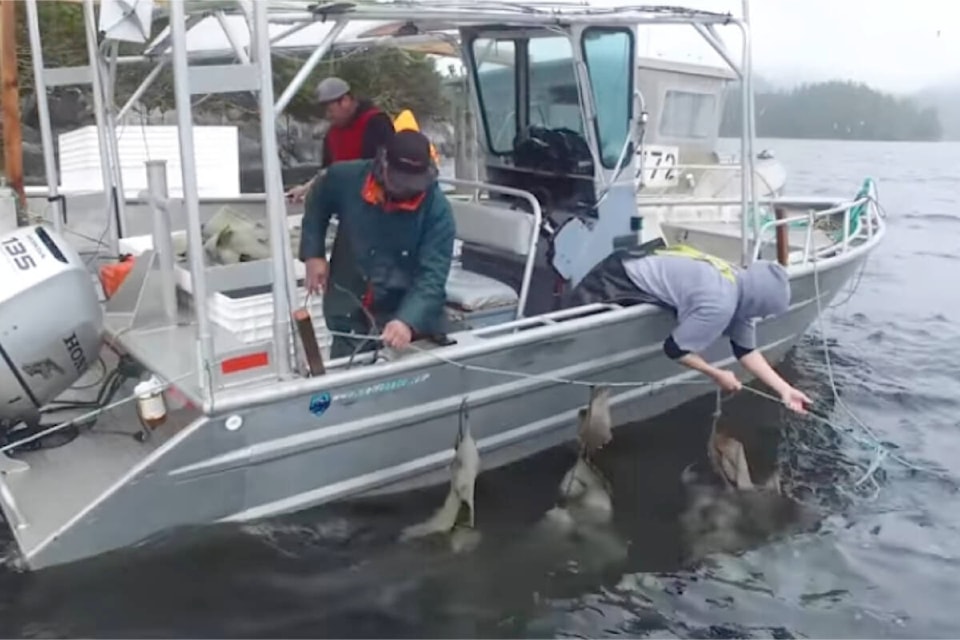Heiltsuk Nation on B.C.’s central coast is suing the Canadian government over a 2022 decision by Fisheries and Oceans Canada (DFO) that banned the nation from its commercial harvest of herring spawn-on-kelp (SOK) fishery.
The nation filed the civil action in BC Supreme Court in mid-December, alleging the prohibition ran contrary to a management plan jointly developed by DFO and the Heiltsuk.
Elected chief Marilyn Slett said upwards of 600 people participate in the commercial harvest of herring spawn-on-kelp (SOK), which normally occurs any time between mid-March to the end of March. The harvest is not of the whole herring, but the eggs which have adhered to blades of kelp after herring have spawned.
Slett said there is a market for SOK, especially overseas and in Japan.
The fishery was closed in 2022, with notice going out one month beforehand, reopened in 2023, and is now closed again.
“SOK is a pivotal species and through that lens we have always managed for the future,” Slett said.
Heiltsuk people can only use the SOK fishery for food, social and ceremonial purposes.
“It’s frustrating more than anything,” Slett said. “We have been working with Fisheries and Oceans Canada for collaborative management and in 2022 it was a unilateral decision to close the fishery.”
She said the Heiltsuk Nation is asking the court to order damages and issue declarations regarding Canada’s infringement of the nation’s rights.
“We did not take the decision to commence legal action lightly,” she added. “We have worked hard to build trust and collaboratively manage herring stocks in Heiltsuk Territory with DFO, however the unilateral decision to close our commercial SOK fishery seriously undermined those efforts and infringed our rights.”
Heiltsuk Nation and DFO had jointly managed the herring fishery since 2016, collecting and sharing data and analysis, and making a joint management recommendation to the Minister of Fisheries and Oceans each year.
In 2022, however, Slett said the minister declined to follow that recommendation, surprising the nation, and undermining incremental reconciliation agreements that had been signed between Canada and Heiltsuk under the banner of “Haíɫcístut,” a Heiltsuk word which means, “to turn things around and make them right again.”
The commercial fishery has been closed over the years, but Slett emphasized the commercial harvest in 2022 would have been a “modest, small” fishery.
“It is one of our main economic drivers, but we always manage it with sustainability in mind,” she said, adding it is important to note it is a non-kill fishery and does not cause fish mortality and is only viable when there is an abundance in the harvest area.
Heiltsuk Hereditary Chief Humchitt said in 2022, unlike sac roe herring fisheries, the SOK fishery does not cause fish mortality and is self-limiting because it is only viable when there is abundant spawn in the harvest area.
“Because the herring themselves are not killed, and only roe (eggs) that attach to certain branches and kelp are harvested, the SOK fishery ensures a healthy run of herring in years to come.”
Slett described it as a very sustainable fishery.
Herring has been the cornerstone of Heiltsuk culture for thousands of years, she added, reminding the public that in 1996, in a case known as R. v. Gladstone, the Supreme Court of Canada confirmed the Heiltsuk Nation’s constitutionally protected Aboriginal right to commercially harvest SOK.
A short film titled Heiltsuk Herring Roe on Kelp, is available on YouTube for people wanting to learn more about the Heiltsuk fishery.
In the film, Heiltsuk Fisherman and Chief Frank Brown said the harvesting of herring roe is a time of renewal for the community.
A traditional method is used which involves putting kelp on a line into the ocean from a boat. The herring then arrive and spawn on the pieces of kelp.
Fisheries and Oceans Canada in an emailed response said because the matter is before the courts it would be inappropriate to comment at this time.
READ MORE: DFO closes herring spawn on kelp fishery at Central Coast against Heiltsuk Nation wishes
Don’t miss out on reading the latest local, provincial and national news offered at Coast Mountain News. Sign up for our free newsletter right to your email here.
